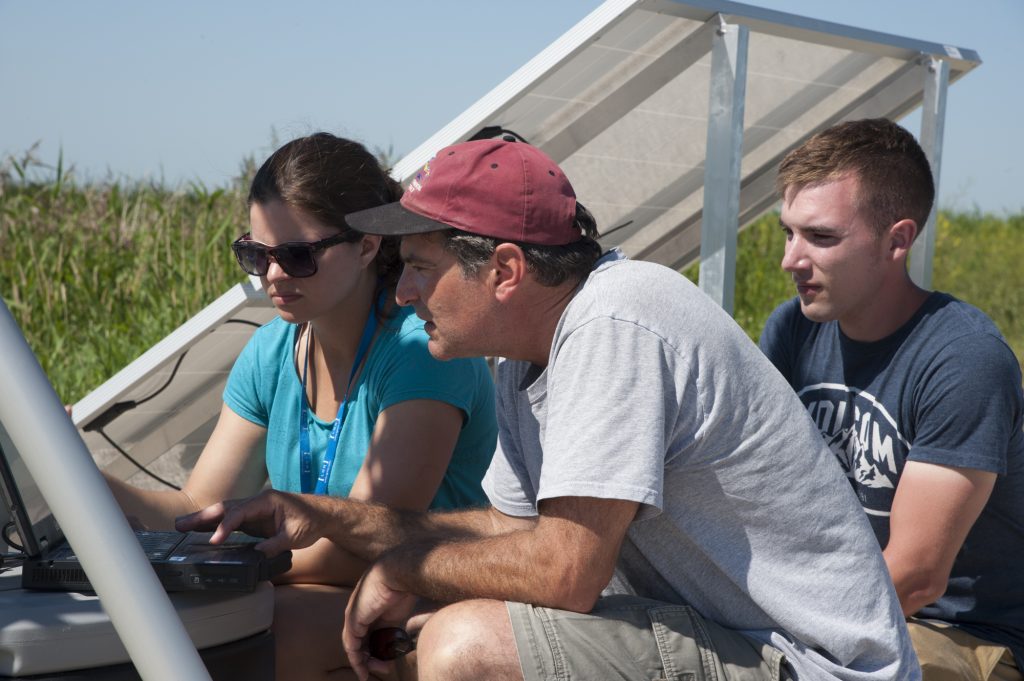Made to measure
DUC teams with Manitoba Hydro and the University of Manitoba to assess the best way to measure greenhouse gas fluxes in aquatic ecosystems

The same technology used to monitor greenhouse gas fluxes at a prairie marsh may soon be deployed at a hydroelectric reservoir in northern Manitoba
Researchers from the University of Manitoba and DUC spent part of their summer at Oak Hammock Marsh, Man. testing four different technologies designed to measure greenhouse gas fluxes.
Greenhouse gases, like carbon dioxide, methane and nitrous oxide, absorb and re-emit radiation from the sun, near the planet’s surface. These gases make Earth habitable, and are naturally occurring. But since the industrial age began, humans have been producing more and more greenhouse gases, which is contributing to climate change.
When measuring fluxes “we’re looking at how much carbon, methane and other greenhouse gases an ecosystem is storing, and what it’s releasing,” says Bryan Page, a DUC research biologist involved with the Manitoba Hydro-funded study.
Being able to accurately measure greenhouse gas flux is important to Manitoba’s primary electricity provider, says Bob Gill, a senior environmental specialist at Manitoba Hydro. For the past 10 years, Manitoba Hydro has measured greenhouse gas flux at their hydroelectric reservoirs as part of their Reservoir Greenhouse Gas program. “It’s important to us to be able to understand our carbon footprint,” says Gill.
There are lots of different ways to measure greenhouse gases.
“If you want to determine the greenhouse gas flux from a clump of cattails, then you’d want to have a chamber system,” says Pascal Badiou, a DUC research scientist who specializes in wetland ecology. Badiou refers to a container capable of isolating a small area of cattail from the atmosphere.
But if researchers want to understand how an entire ecosystem captures and releases greenhouse gases, they would use another system. Other systems commonly used to measure the exchange of gases at the ecosystem scale, feature specialized sensors mounted on a tower downwind from the system.
These micrometeorological sensors capture the contribution by all parts of the ecosystem (cattails, open water, grasses, etc.) on certain properties of the air. Researchers can then use the data they collect to form a complete picture of how much gas flows vertically between the air and wetland.
Testing the different technologies at Oak Hammock Marsh were researchers from the University of Manitoba’s Centre for Earth Observation Science (CEOS). “We have been active in the measurement of air-surface greenhouse gas exchange for many years, and over several different surfaces, including: oceans, wetlands, forests and agricultural systems,” says Tim Papakyriakou, a doctor of geography and the director of CEOS.
“The role of our researchers in this study is to compare measurements using different micrometeorological techniques, and summarize the relative benefits of each for the Crown corporation,” says Papakyriakou.
According to Gill, depending on the report Manitoba Hydro receives from researchers at CEOS, one or more of the technologies assessed may be stationed at the planned Keeyask Generating Station reservoir, on the lower Nelson River.
One technology reviewed as part of the summer project was the futuristic-looking eddy covariance system, which features micrometeorological sensors. Tall and mast-like in appearance, an eddy covariance measures methane and carbon dioxide levels, wind-speed and temperature, several metres above the surface of the wetland and at very high rates.
“Measurements are taken between 10 and 20 times a second,” says Papakyriakou. The high frequency measurements can be used to calculate a flux in greenhouse gases.

©DUC
The approach has been successfully used for decades over a variety of different surfaces, and unlike a chamber system that measures the greenhouse gas flux of a small enclosed area, the eddy covariance technique will measure the air-ecosystem flow of greenhouse gases over large portions of the ecosystem.
It’s a piece of technology Manitoba Hydro may deploy at the Keeyask Generating Station, and one that Badiou would also like to see used at wetland sites throughout the prairie pothole region.
“We know that wetlands are tremendously productive systems. They’re really important terrestrial carbon stores or sinks,” says Badiou.
However, while wetlands store greenhouse gases, they also produce them, specifically methane. Badiou wants to learn how long it takes for wetlands to become greenhouse gas sinks—places that store more gas than they emit.
“We don’t have a good handle on how important methane emissions from prairie wetlands are—or if they’re important at all,” says Badiou.
He’d like to bridge that knowledge gap. “We need to be able to estimate how effective wetland restoration will be to mitigate climate change and how long it might take for those systems to benefit the climate.”
But one thing is definite, says Badiou.
“The existing science is clear. Conserving existing and intact wetlands is important. They’re at a point where they are acting as carbon sinks and having a net-cooling effect on the atmosphere.”

©Mario Palumbo, Manitoba Hydro



